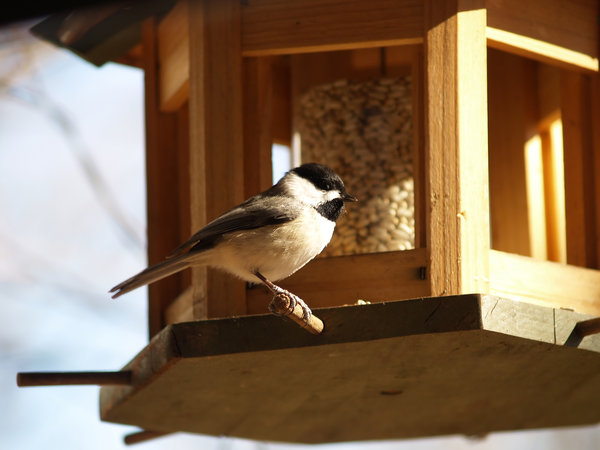These small songbirds, known as chickadees, are constantly on the go in search of insects and are frequent visitors to bird feeders in the backyard.
They belong to the avian family known as Poecile.
In this article, I will teach you about the Types of Chickadees in Florida.
| Image | Name |
|---|---|
 | Carolina chickadee |
Types Of Chickadees In Florida
In Florida, you’ll only see Carolina Chickadees, not any other kind of Chickadee.
Carolina Chickadee

Approximately 11% of summer and winter checklists for Florida include Carolina Chickadees, proving that they may be seen year-round in the state.
The Black-capped Chickadee’s close relative, the Carolina Chickadee, is replaced by this bird throughout the southeastern United States.
It is less common to observe this species at bird feeders in warmer areas, although it has been known to go into residential yards in search of sunflower seeds.
Interbreeding between Black-capped and Carolina chickadees is common in areas where their ranges overlap.
Also, in these zones of interaction, they might pick up on one other’s songs and start singing them themselves, which can be quite confusing to birdwatchers.
Feeding Behavior
Usually hops from branch to branch, picking off anything it can reach; however, it has been seen hanging upside-down to get to the underside of branches.
Hovering to eat is not uncommon, and so is flying out to grab insects in flight.
Puts food away and then gets it out again. Visits feeders in search of food.
Eggs
White with tiny brown or red spots, usually clustered at the bigger end; 5 to 8 inches long.
Females are very certainly the only ones who can incubate eggs for the full 11 to 13 days.
If an adult bird gets startled while sitting on its nest, it will hiss loudly, much like a snake.
It’s common for both parents to take turns feeding their young. About 13 to 17 days after hatching, the young will depart the nest.
Diet
The majority of them are insects, seeds, and berries. Likely relies on fruits and vegetables (seeds and berries) more during the colder months.
During the warmer months, the majority of its food consists of caterpillars.
It also eats moths, beetles, true bugs, aphids, and other insects, as well as spiders.
They consume a wide variety of plant matter, including berries, seeds, and other tiny fruits, as well as weeds.
Nesting
Possible lifelong commitment between partners. It’s likely that pairs develop in the autumn and stick together throughout the winter.
Late in the winter, as the flocks disperse, the couple begins to set their nesting area.
The nest is located in a hole 5 to 15 feet from the ground and is frequently an enlarged natural hollow in dead wood, an old woodpecker hole, or a nesting box.
Both sexes contribute to the process of excavating or enlarging a natural hole.
The nest’s (likely female-built) framework consists of strips of bark or other material, while the nest’s (also female-built) interior is lined with plant down and animal hair.
About Chickadees
Even though chickadees don’t migrate, they may nonetheless go to lower ground during the winter months.
Research has demonstrated that chickadees survive the winter by storing food, using cavities as roosts, and entering a condition of controlled nocturnal hypothermia.
In order to maintain their high body temperature, chickadees need to eat the equivalent of their body weight every day.
The average lifespan of a chickadee is about 2 to 3 years, and some only make it to adulthood and reproduce after one year.
On the other hand, chickadees with lifespans of 12 years have been documented in this region.
Since male and female chickadees look identical, the only way to tell them apart is by the loud “Feee Beee” song that only the males sing.
Aside from bugs, chickadees also enjoy suet and seeds, which can be easily provided at backyard feeders.
Conclusion
The Chickadee has a reputation for daring acrobatics.
Because of the power of their legs and feet, they may balance precariously on the feeders and plants.
They’ll utilize a bird bath with no concerns, and their antics in the water may be great fun to watch.
So, heed my advice and hang a feeder so you may see and learn about these endearing birds.
FAQ
What other bird resembles a chickadee in appearance? However, is that not the case?
In comparison to the Carolina Chickadee, the white-breasted nuthatch has a larger beak, a shorter tail, and no black neck patch. In contrast to chickadees, nuthatches prefer to perch on the trunks and huge branches of trees rather than on low branches.
What sets chickadees different from finches?
Chickadees: Chickadees seem similar to finches and sparrows at a glimpse; however, their coloring is more pied than either species, and they are far more active and acrobatic. They cluster together and have distinctive facial characteristics.
Last Updated on March 22, 2023 by Lily Aldrin
